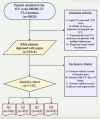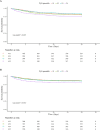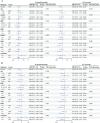A retrospective study utilized MIMIC-IV database to explore the potential association between triglyceride-glucose index and mortality in critically ill patients with sepsis
- PMID: 39402158
- PMCID: PMC11473526
- DOI: 10.1038/s41598-024-75050-8
A retrospective study utilized MIMIC-IV database to explore the potential association between triglyceride-glucose index and mortality in critically ill patients with sepsis
Abstract
Triglyceride-glucose (TyG) index has emerged as a novel biomarker for detecting insulin resistance (IR) and has been proven to be associated with various diseases. However, its correlation with the prognosis of severe sepsis remains unraveled. This retrospective cohort study utilized patient records from the Medical Information Mart for Intensive Care (MIMIC-IV, version 2.2) to examine the outcomes of patients with sepsis. The primary outcomes were hospital mortality and intensive care unit (ICU) mortality. The correlation between the TyG index and outcomes was evaluated through the Kaplan-Meier method, the Log-rank test, and univariate and multivariate Cox regression analyses. Additionally, restricted cubic spline (RCS) regression analysis was employed to delve into the nonlinear relationship between baseline TyG index and outcomes, with trend significance assessed through quartile levels. Subgroup analyses were conducted to evaluate the consistency of the TyG index's prognostic value across various influencing factors. The study included 1,742 patients with sepsis requiring intensive care. The in-hospital mortality rate was 19.75% (344/1,742), and the ICU mortality rate was 14.75% (257/1,742). Cox regression analysis revealed that, in comparison to the first quartile (Q1), patients in the fourth quartile (Q4) had a 63% higher risk of in-hospital mortality (HR 1.63 [95% CI 1.22 to 2.18], P < 0.01) and a 79% higher risk of ICU mortality (HR 1.79 [95% CI 1.28 to 2.51], P < 0.001). Model 3 showed that ICU mortality risks for Q4, Q3, and Q2 were 240%, 75%, and 33% higher, respectively (HR 3.40 [95% CI 2.24 to 5.16], P < 0.001; HR 1.75 [95% CI 1.16 to 2.63], P = 0.007; HR 1.33 [95% CI 1.20 to 1.53], P < 0.001). RCS regression analysis identified a nonlinear association between the TyG index and mortality (overall P < 0.001; P for nonlinearity < 0.001, with an inflection point at 8.9). Subgroup analysis showed that the effect size and direction were consistent across different subgroups, suggesting the stability of the results. This study demonstrates that a higher TyG index is significantly associated with increased in-hospital and ICU mortality risk in critically ill sepsis patients, with evidence of non-linear correlation. Therefore, the TyG index helps identify the mortality prognosis of sepsis patients in the ICU.
Keywords: Intensive care unit; MIMIC; Mortality; Sepsis; Triglyceride glucose index.
© 2024. The Author(s).
Conflict of interest statement
The authors declare no competing interests.
Figures




Similar articles
-
Elevated Triglyceride-Glucose (TyG) Index Predicts Poor Clinical Outcomes in Critically Ill AECOPD Patients: A Retrospective Study.Int J Chron Obstruct Pulmon Dis. 2024 Oct 1;19:2217-2228. doi: 10.2147/COPD.S477268. eCollection 2024. Int J Chron Obstruct Pulmon Dis. 2024. PMID: 39371919 Free PMC article.
-
Triglyceride-glucose index as a potential predictor for in-hospital mortality in critically ill patients with intracerebral hemorrhage: a multicenter, case-control study.BMC Geriatr. 2024 May 1;24(1):385. doi: 10.1186/s12877-024-05002-4. BMC Geriatr. 2024. PMID: 38693481 Free PMC article.
-
Association between triglyceride-glucose index and in-hospital mortality in critically ill patients with sepsis: analysis of the MIMIC-IV database.Cardiovasc Diabetol. 2023 Nov 8;22(1):307. doi: 10.1186/s12933-023-02041-w. Cardiovasc Diabetol. 2023. PMID: 37940931 Free PMC article.
-
Independent effect of the triglyceride-glucose index on all-cause mortality in critically ill patients with chronic obstructive pulmonary disease and asthma: A retrospective cohort study.Chron Respir Dis. 2024 Jan-Dec;21:14799731241245424. doi: 10.1177/14799731241245424. Chron Respir Dis. 2024. PMID: 38607315 Free PMC article.
-
Association between the triglyceride glucose index and the risk of acute kidney injury in critically ill patients with hypertension: analysis of the MIMIC-IV database.Front Endocrinol (Lausanne). 2024 Jul 12;15:1437709. doi: 10.3389/fendo.2024.1437709. eCollection 2024. Front Endocrinol (Lausanne). 2024. PMID: 39072271 Free PMC article.
References
-
- Rosendo-Silva, D., Viana, S., Carvalho, E., Reis, F. & Matafome, P. Are gut dysbiosis, barrier disruption, and endotoxemia related to adipose tissue dysfunction in metabolic disorders? Overview of the mechanisms involved. Intern. Emerg. Med.18(5), 1287–1302. 10.1007/s11739-023-03262-3 (2023). - PMC - PubMed
MeSH terms
Substances
Grants and funding
- 2022-F17/Project of NINGBO Leading Medical & Health Discipline
- 2023030615/Ningbo Top Medical and Health Research Program
- 2022HMKY48/HwaMei Reasearch Foundation of Ningbo No.2 Hospital
- 2023HMZD07/HwaMei Reasearch Foundation of Ningbo No.2 Hospital
- 2023RC081/Medical Scientific Reasearch Foundation of Zhejiang Province
LinkOut - more resources
Full Text Sources
Medical

